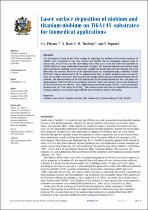 ResearchSpace
ResearchSpace
Laser surface deposition of niobium and titanium-niobium on Ti6A14V substrates for biomedical applications
JavaScript is disabled for your browser. Some features of this site may not work without it.
- ResearchSpace
- →
- Research Publications/Outputs
- →
- Journal Articles
- →
- View Item
| dc.contributor.author |
Pityana, Sisa L

|
|
| dc.contributor.author |
Baloyi, N

|
|
| dc.contributor.author |
Tlotleng, Monnamme

|
|
| dc.contributor.author |
Popoola, P

|
|
| dc.date.accessioned | 2019-12-17T07:41:57Z | |
| dc.date.available | 2019-12-17T07:41:57Z | |
| dc.date.issued | 2019-04 | |
| dc.identifier.citation | Pityana, S.L., Baloyi, N., Tlotleng, M. & Popoola, P. 2019. Laser surface deposition of niobium and titanium-niobium on Ti6A14V substrates for biomedical applications. Journal of the Southern African Institute of Mining and Metallurgy, vol 119(4), pp. 385-389 | en_US |
| dc.identifier.issn | 2225-6253 | |
| dc.identifier.issn | 2411-9717 | |
| dc.identifier.uri | https://www.saimm.co.za/Journal/v119n04p385.pdf | |
| dc.identifier.uri | http://www.scielo.org.za/scielo.php?script=sci_arttext&pid=S2225-62532019000400010 | |
| dc.identifier.uri | http://dx.doi.org/10.17159/2411-9717/16/211/2019 | |
| dc.identifier.uri | http://hdl.handle.net/10204/11263 | |
| dc.description | Copyright: 2019 Southern African Institute of Mining and Metallurgy. | en_US |
| dc.description.abstract | The advantages of using Nb and Ti-Nb coatings for improving the hardness and corrosion resistance of Ti6Al4V were investigated. It has been reported that Ti6Al4V used in orthopaedic implants tends to release toxic Al and V ions into the surrounding tissue. Thin layers of Nb and Ti-Nb were deposited on Ti6Al4V substrates using a laser metal deposition technique. The deposited material was analysed using optical microscopy, scanning electron microscopy coupled with energy dispersive spectroscopy, and X-ray diffraction. The corrosion behaviour of the deposited layers was investigated using a Metrohm Autolab PG Stat101 compact potentiostat at 25°C in simulated body fluid. A Vickers hardness system was used to study the mechanical properties. Both Nb and Ti-Nb coatings exhibited good metallurgical bonding with the substrate. The microstructure and the XRD analyses for the Nb system showed that the a-Nb phase was most dominant, while the Ti-Nb system comprised a mixture of the a and b phases. The average hardness of the Ti6Al4V substrate was 350 HV(sub0.3), with a slight increase for the Nb coating (363 HV(sub0.3)) and a much higher hardness from the Ti-Nb coating at 423 HV(sub0.3). The corrosion results show that the deposited Nb was more corrosion-resistant in the solution than either the Ti6Al4V substrate or the Ti-Nb coating. | en_US |
| dc.language.iso | en | en_US |
| dc.publisher | Southern African Institute of Mining and Metallurgy | en_US |
| dc.relation.ispartofseries | Workflow;22802 | |
| dc.subject | Corrosion | en_US |
| dc.subject | Laser surface deposition | en_US |
| dc.subject | Niobium (Nb) | en_US |
| dc.subject | Titanium (Ti) | en_US |
| dc.subject | Titanium-niobium (Ti-Nb) | en_US |
| dc.subject | Ti6Al4V | en_US |
| dc.title | Laser surface deposition of niobium and titanium-niobium on Ti6A14V substrates for biomedical applications | en_US |
| dc.type | Article | en_US |
| dc.identifier.apacitation | Pityana, S. L., Baloyi, N., Tlotleng, M., & Popoola, P. (2019). Laser surface deposition of niobium and titanium-niobium on Ti6A14V substrates for biomedical applications. http://hdl.handle.net/10204/11263 | en_ZA |
| dc.identifier.chicagocitation | Pityana, Sisa L, N Baloyi, Monnamme Tlotleng, and P Popoola "Laser surface deposition of niobium and titanium-niobium on Ti6A14V substrates for biomedical applications." (2019) http://hdl.handle.net/10204/11263 | en_ZA |
| dc.identifier.vancouvercitation | Pityana SL, Baloyi N, Tlotleng M, Popoola P. Laser surface deposition of niobium and titanium-niobium on Ti6A14V substrates for biomedical applications. 2019; http://hdl.handle.net/10204/11263. | en_ZA |
| dc.identifier.ris | TY - Article AU - Pityana, Sisa L AU - Baloyi, N AU - Tlotleng, Monnamme AU - Popoola, P AB - The advantages of using Nb and Ti-Nb coatings for improving the hardness and corrosion resistance of Ti6Al4V were investigated. It has been reported that Ti6Al4V used in orthopaedic implants tends to release toxic Al and V ions into the surrounding tissue. Thin layers of Nb and Ti-Nb were deposited on Ti6Al4V substrates using a laser metal deposition technique. The deposited material was analysed using optical microscopy, scanning electron microscopy coupled with energy dispersive spectroscopy, and X-ray diffraction. The corrosion behaviour of the deposited layers was investigated using a Metrohm Autolab PG Stat101 compact potentiostat at 25°C in simulated body fluid. A Vickers hardness system was used to study the mechanical properties. Both Nb and Ti-Nb coatings exhibited good metallurgical bonding with the substrate. The microstructure and the XRD analyses for the Nb system showed that the a-Nb phase was most dominant, while the Ti-Nb system comprised a mixture of the a and b phases. The average hardness of the Ti6Al4V substrate was 350 HV(sub0.3), with a slight increase for the Nb coating (363 HV(sub0.3)) and a much higher hardness from the Ti-Nb coating at 423 HV(sub0.3). The corrosion results show that the deposited Nb was more corrosion-resistant in the solution than either the Ti6Al4V substrate or the Ti-Nb coating. DA - 2019-04 DB - ResearchSpace DO - 10.17159/2411-9717/16/211/2019 DP - CSIR KW - Corrosion KW - Laser surface deposition KW - Niobium (Nb) KW - Titanium (Ti) KW - Titanium-niobium (Ti-Nb) KW - Ti6Al4V LK - https://researchspace.csir.co.za PY - 2019 SM - 2225-6253 SM - 2411-9717 T1 - Laser surface deposition of niobium and titanium-niobium on Ti6A14V substrates for biomedical applications TI - Laser surface deposition of niobium and titanium-niobium on Ti6A14V substrates for biomedical applications UR - http://hdl.handle.net/10204/11263 ER - | en_ZA |





